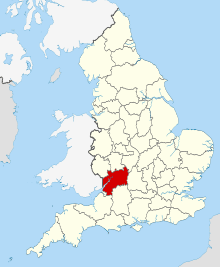Prinknash Abbey
Prinknash Abbey (pronounced locally variously as "Prinidge/Prinnish"[1]) (IPA: /ˈprɪnɪdʒ/[2]) is a Roman Catholic monastery in the Vale of Gloucester in the Diocese of Clifton, near the village of Cranham. It belongs to the English Province of the Subiaco Cassinese Congregation, which is itself part of the worldwide Benedictine Confederation. It is noted for its manufacturing of incense, and is the largest manufacturer of incense in Europe. [3]
 St Peter's Grange, Prinknash Abbey | |
| Monastery information | |
|---|---|
| Order | Benedictine, Subiaco Congregation |
| Established | 681 at Gloucester as St. Peter's Abbey |
| Disestablished | 1539 |
| Reestablished | 1928 |
| Mother house | Benedictine monks of Caldey Island |
| Diocese | Diocese of Clifton (Roman Catholic Church) |
| People | |
| Founder(s) | Abbot Serlo (1072–1104), re-founded under Ælred Carlyle (1928) |
| Important associated figures | Dom Bede Griffiths, Ælred Carlyle, Stephen Horton |
History
For nearly 900 years the land known as Prinknash (locally pronounced “Prinich” or “Prinish”) has been associated with Benedictine monks. In 1096 the Giffard family, who had come to England with William the Conqueror, made a gift of the land to Serlo, Abbot of Saint Peter's, Gloucester. A large part of the present building was built during the abbacy of William Parker, the last Abbot of Gloucester, around the year 1520.
It remained in the abbey's hands until the suppression of the monasteries in 1539 when it was rented from the Crown by Sir Anthony Kingston who was to provide 40 deer annually to King Henry VIII, who used the House as a hunting lodge. Prinknash Park continued to be used as a home for the gentry and nobility of Gloucestershire during the next few centuries and each generation left its mark on the property.[4]
On 1 August 1928 a Deed of Covenant was made out by the twentieth Earl of Rothes, the grandson of Thomas Dyer Edwards, a Catholic convert, whose wish was that Prinknash should be given to the Benedictine monks of Caldey Island. These monks had converted from Anglicanism to Roman Catholicism in 1913 under the leadership of Abbot Ælred Carlyle, although he left monastic life in 1921 to work as a missionary priest in Vancouver.[5]
Caldey Island was eventually sold to the Cistercian monks and on 26 October 1928 six Benedictine monks arrived from Caldey to convert the house at Prinknash into a monastery. The rest soon followed and after some years of poverty they managed to purchase all the land around the house to make Prinknash as it is today. Fr. Wilfrid Upson, who had been appointed Prior after Carlyle's departure, was elected the first Abbot of Prinknash in 1937.[6] The bones of Richard Whiting, the last Abbot of Glastonbury, are kept at Prinknash.[5]
.jpg)
The community continued to grow, beginning with 25 monks. There are now 9 at Prinknash itself and more are spread over three monasteries, a foundation being made at Farnborough in May 1947 and in Pluscarden in Scotland later that year. In 1939 a foundation stone for a new abbey was laid at Prinknash by Cardinal Hinsley, but the Second World War intervened and the previous impracticable building plans were eventually redrawn by F.G. Broadbent.
The monks moved into the new abbey in 1972 and the old abbey was re-roofed, re-furnished, and converted into a retreat and conference centre, known as "St Peter's Grange". However, by 2008 the now smaller community of monks had decided to move back to St Peter's Grange, and this took place on the Feast of Saints Peter and Paul (30 June).
Forms of the Roman Rite used at Mass
The forms of Mass celebrated at the abbey vary.
Earlier, it was reported here that Prinknash had regular celebrations using the 1962 Roman Missal: a Low Mass each Saturday at 11.00 am and on the first Sunday of the month at 3.00 p.m.(except on certain occasions, as notified by website or telephone); and a Missa Cantata on certain high feasts and holy days and, on other days, Low Mass at 8.15 in the morning.
In August 2019 the abbey stated on its website that it had "Low Mass" on Monday to Friday mornings at about 7:30, the exact time depending on the time of concluding lauds, but it described this "Low Mass" as celebrated "in English with sung Gospel Acclamation, Sanctus, Eucharistic Acclamation, & Conclusion of the Eucharistic Prayer" and therefore incompatible with the 1962 Roman Missal, and it also indicated that the Scripture readings are those in the post-Vatican II lectionary. It said explicitly that the Saturday Mass, sung in Latin, was in the post-Vatican II form. Its description of the Sunday Mass was: "Solemn, with Incense, Chants from Kyriale & Graduale Romanum".[7] This description too is in conformity with the 2002 General Instruction of the Roman Missal.[8]
Art
In 1972-3, Brother Patrick, a monk of Prinknash, contributed the design and manufacture of a number of items at Clifton Cathedral, Bristol. These included the votive candelabra hanging in the Lady Chapel, made from twenty stainless steel equilateral triangles (a regular icosahedron), and the decorative screens to the Blessed Sacrament Chapel.[9]
Notes
1. ^ According to their website and their video about making incense: https://www.youtube.com/watch?v=3dSci5hMsf0
References
- https://h2g2.com/edited_entry/A19773499/conversation/view/F6584556/T4695829
- Wells, J C (1990). Longman Pronunciation Dictionary. Harlow: Longman. p. 558. ISBN 0-582-05383-8.
- "Prinknash Abbey Incense"
- "History of Prinknash". Prinknash Abbey Trustees. Archived from the original on 12 August 2014. Retrieved 10 August 2014.
- Anson, Peter. Abbot Extraordinary. A Memoir of Abbot Aelred Carlyle, Monk and Missionary. Faith Press, 1958, pp.131–132.
- Downs, James. A Monk and His Movies, 23 October 2013. Retrieved 20 September 2014.
- Mass and Divine Office in the Monastery (August 2019)
- The General Instruction of the Roman Missal (Liturgy Office, England & Wales), 48
- Harrison, Peter (2020). Guide to Clifton Cathedral. Bristol: Clifton Cathedral.

